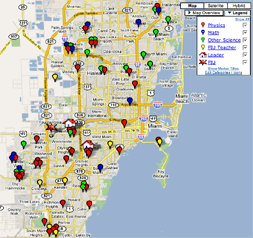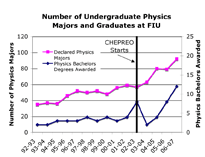| |
Physics Learning Center and education reform: CHEPREO's educational outreach component has been highly successful in growing a learning and research community centered on high energy physics, with educational reform and cutting-edge science serving as its foundation. The CHEPREO-supported Physics Learning Center (PLC) has become the nucleus for educational reform efforts in the Physics Department at FIU. The PLC supports a multi-level community through the activities housed there and the participants utilizing the space. The centerpiece of the PLC is our studio classroom, in which our undergraduate modeling classes are held, summer three-week modeling workshops are run, undergraduate open labs operate, local modeling teachers alliance (aka FizMo) and undergraduates hold regular meetings, and high school outreach activities originate. The PLC also includes a lounge area, conference room, office space, and the high energy physics laboratory. These activities and spaces create an environment where all community members engage each other on a continual basis. Undergraduate CHEPREO fellows and faculty connect with the modeling students during class, open labs, and informally as they visit the PLC. Fellows, undergraduate majors, and graduate students take over the space outside of classes to study and work with each other. High school teachers come for meetings and workshops, and find themselves working with FIU students and faculty. Teachers bring their experiences back to the classroom for their students, leading to exuberant outreach activities at FIU. All community members engage the high school students and their parents during open-house and advanced lab visits.
Evidence for the community's success is seen through multiple indicators. Ninety-one high school teachers have participated in summer workshops and 8 show their commitment through regular meetings and/or taking on leadership roles within the community (see Figure 3). At FIU, the modeling courses are overwhelmingly popular, with requests roughly three to four times the enrollment capacity. These courses are turning out increasingly well-prepared students as seen in their FCI (Force Concept Inventory) post-test scores being 30% higher and a DFW (students withdrawing or receiving a D or F grade) rate that is four times lower than those in the traditional classes at FIU. These courses, as well as other support within the physics department, are showing evidence of increased enrollment in the undergraduate physics program at FIU. Modern physics enrollment is up 130% in Fall 2007 as compared to enrollment averages from 1996-2006. Graduate rates are steadily rising 25% over the past 15 years (Figure 4), during which the national number of physics graduates remained essentially constant [AIP].
For more information
visit the website.

|

|
Figure 1: Community Diagram of Miami Dade County Teacher Participation. Balloons indicate the school location for teacher, pre-service teacher, and leader modeling workshop participation. |
Figure 2: Number of FIU physics degrees granted and intended and declared physics majors from 1992 - 2007 |
Grid education: While not the centerpiece of the CHEPREO E&O efforts, FIU's capabilities in offering education and outreach in the area of grid computing have increased dramatically. Grid computing enables development of large scale applications that require the use of computational, storage, and network resources that are geographically distributed and cross multiple administrative domains. In the first phase of our work, we broadly covered these issues in our curriculum development; however, the main focus was on computational resources. For many large scale applications, addressing the storage and networking resources is equally important. In the next phase of our work (Years 6-10 of CHEPREO), we plan to extend the current tutorial and develop educational materials for storage and networking resources within the grid framework. A range of related topics will also be covered that includes service-oriented grids, meta-scheduling, job flow management, and application grid enablement
|
 |
